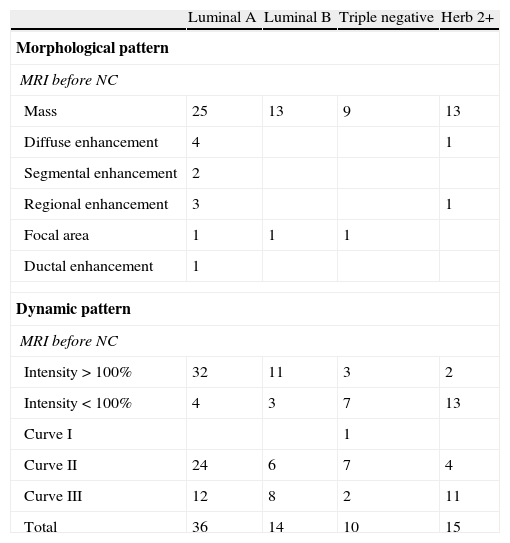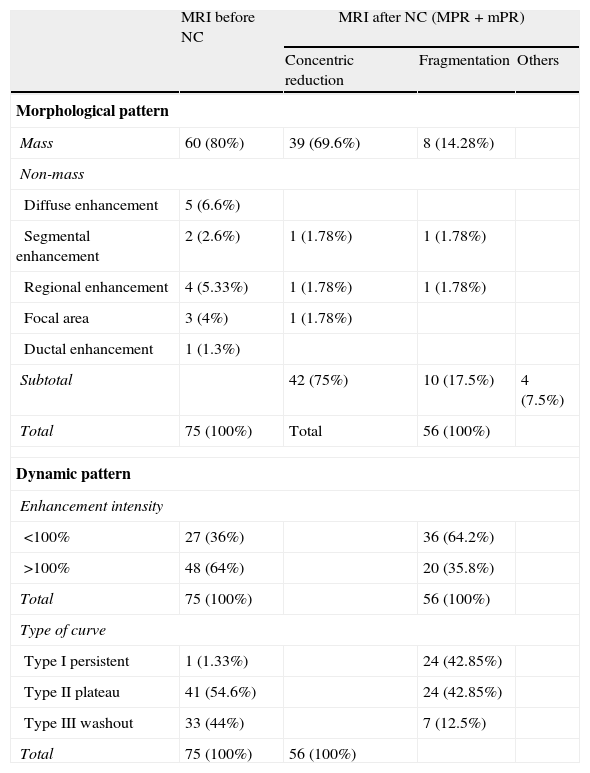MRI is an imaging technique that is best suited for evaluating the response to neoadjuvant chemotherapy for locally advanced breast cancer. We aimed to (a) quantify the response in the molecular subtypes, (b) describe the morphological and dynamic variation, and (c) determine whether the molecular phenotype changes after chemotherapy.
Material and methodsThis is a retrospective study of 75 carcinomas in 69 patients who underwent MRI both before and after neoadjuvant chemotherapy. The response to treatment was classified as (a) complete response, (b) major partial response, (c) minor partial response, or (d) no response. We quantified the response in each molecular subtype (luminal A, luminal B, Herb 2+, and triple negative). The morphological changes were classified as (a) concentric reduction, (b) fragmentation, (c) ductal enhancement, or (d) necrosis. The dynamic changes affected the maximum intensity peak and the post-initial enhancement.
ResultsIn the 4 molecular subtypes, 4 types of response were seen. The response was good in 84.6% of the triple negative subtype, in 76.9% of the luminal B subtype, in 75.6% of the luminal A subtype, and in 69.2% of the Herb 2+ subtype. The predominant morphological change was concentric reduction (75%). The predominant dynamic change was a decrease in the maximum intensity peak (<100% in 64.2%), and type I or II curves were seen in 85.7%.
ConclusionsThe triple negative subtype responded best to neoadjuvant chemotherapy. The most common changes were concentric reduction and a decrease in the maximum intensity peak, with fewer washout curves. We observed a change in the molecular phenotype between the specimen at diagnosis and the final study in 12.2% of cases.
La RM es la técnica de imagen que mejor valora la respuesta a la quimioterapia neoadyuvante en el cáncer de mama localmente avanzado. Los objetivos son: primero, cuantificar la respuesta en los subtipos moleculares; segundo, describir las variaciones morfológicas y dinámicas, y tercero, valorar si el fenotipo molecular se modifica tras la quimioterapia.
Material y métodosEstudio retrospectivo de 75 carcinomas, en 69 pacientes con quimioterapia neoadyuvante. Se realizó RM pre y post-tratamiento. La respuesta se clasificó en: respuesta completa; respuesta parcial mayor; respuesta parcial menor y sin respuesta, cuantificando cada una en cada subtipo molecular (luminal A, luminal B, Herb 2+ y triple negativo). Los cambios morfológicos fueron: reducción concéntrica, fragmentación, realce ductal y necrosis. Los cambios dinámicos afectaron al pico de intensidad máxima y al realce post-inicial.
ResultadosEn los 4 subtipos moleculares se observaron los 4 tipos de respuesta. El triple negativo tuvo 84,6% de buenas respuestas, seguido del luminal B (76,9%), luminal A (75,6%), y Herb 2+ (69,2%). El cambio morfológico que predominó fue la reducción concéntrica en el 75% y el dinámico fue la disminución del pico de intensidad máxima, <100%, en el 64,2%, con predominio de curvas tipo I y II en el 85,7%.
ConclusionesEl subtipo triple negativo es el que mejor respondió a la quimioterapia neoadyuvante. Los cambios más frecuentes fueron la reducción concéntrica y la disminución del pico de intensidad máxima con menos curvas de lavado. El cambio del fenotipo molecular fue del 12,2%, entre la muestra al diagnóstico y el estudio final.
Artículo
Comprando el artículo el PDF del mismo podrá ser descargado
Precio 19,34 €
Comprar ahora













